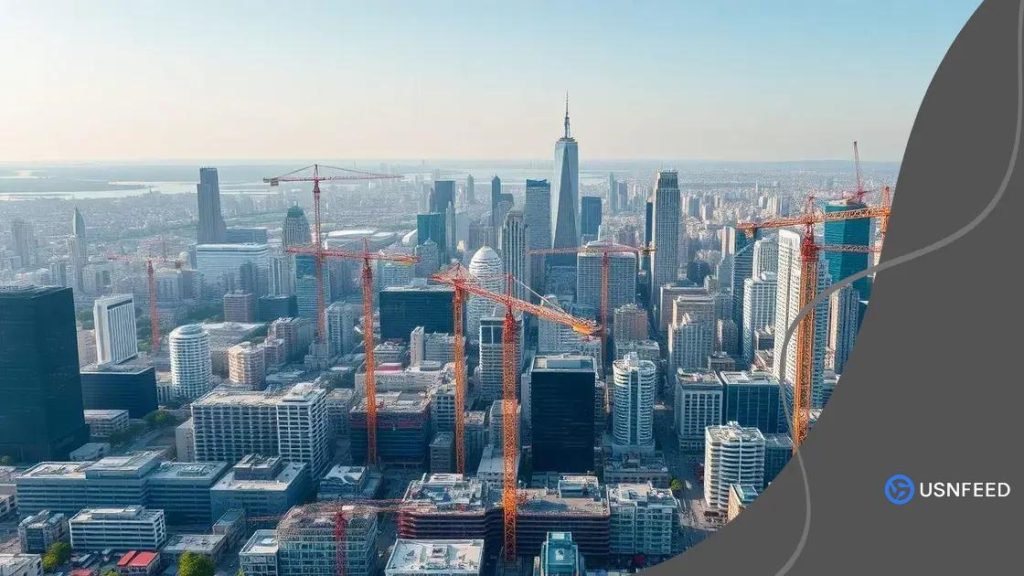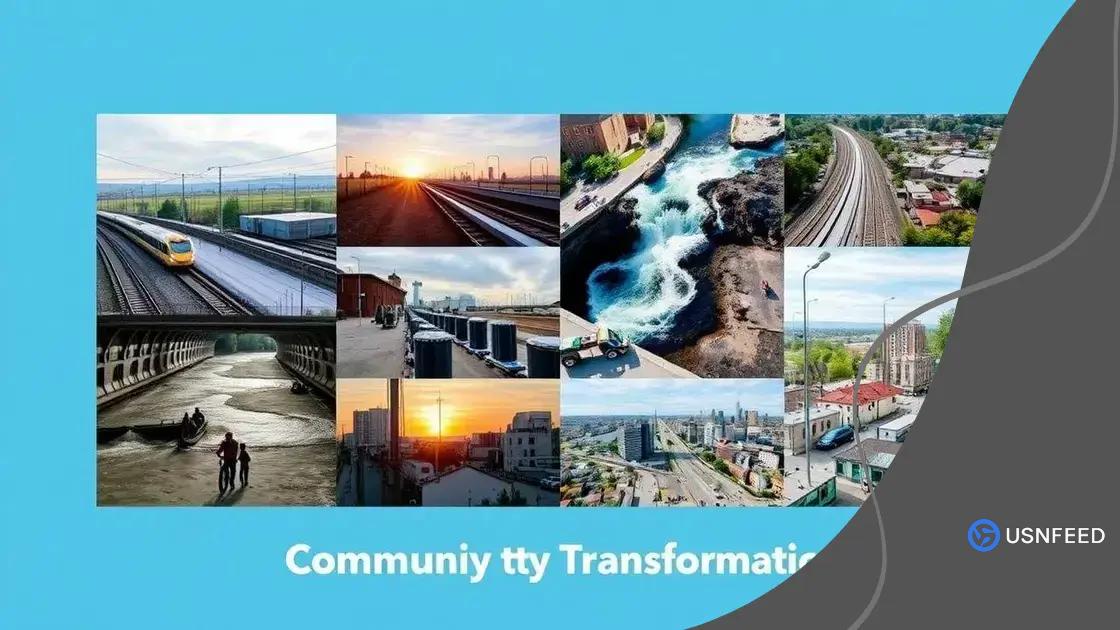Infrastructure development projects that can transform communities

Infrastructure development projects focus on creating sustainable, efficient, and innovative solutions like smart cities, green infrastructure, and modular construction to improve community quality of life and meet modern demands.
Infrastructure development projects play a crucial role in enhancing the quality of life for communities. Have you ever wondered how such projects can reshape our surroundings and improve daily living? Let’s dive into the transformative potential of these initiatives..
Understanding the importance of infrastructure development
Understanding the importance of infrastructure development is key to realizing how communities grow and thrive. This process involves creating essential services that allow people to live, work, and play more effectively.
Why Infrastructure Matters
Infrastructure serves as the backbone of society. It includes roads, bridges, and public transport systems. Each piece acts as a vital connection, making it easier for people to travel and access services.
Benefits of Strong Infrastructure
- Economic Growth: More efficient systems lead to better business opportunities.
- Improved Safety: Well-constructed roads and bridges reduce accidents and hazards.
- Enhanced Quality of Life: Access to parks and recreational areas promotes well-being.
When we consider various infrastructure development projects, from urban settings to rural towns, their importance becomes even clearer. Communities benefit from upgraded facilities as they attract new businesses and create jobs. Improved infrastructure also leads to better public health, as it ensures clean water and effective waste disposal.
Another aspect to note is how infrastructure development can influence education and technology access. Schools with proper facilities and internet connectivity can foster learning, making education more accessible for everyone.
Significance of Investment
Investing in infrastructure development is crucial for long-term success. Often, local governments and communities join forces to secure funding for these necessary projects. This collaboration creates a sense of ownership while driving progress.
Ultimately, as we move towards the future, the emphasis on strong and sustainable infrastructure cannot be overlooked. The way we build today shapes the lives of future generations. Whether it’s through transportation systems or digital networks, the choices made now will influence daily living for years to come.
Thus, understanding the layers of infrastructure development enhances not only individual lives but entire communities.
Key types of infrastructure projects
Understanding the key types of infrastructure projects can help us appreciate how they shape our communities. These projects are essential for providing basic services and enhancing quality of life.
Transportation Infrastructure
Transportation projects include roads, highways, railways, and airports. They connect people and goods, ensuring smooth transit. A well-designed transport system boosts local economies and reduces travel time.
Water and Sanitation Projects
Water infrastructure is vital for public health. Projects might include building water treatment plants, pipelines, and sewage systems. Access to clean water and sanitation facilities prevents the spread of diseases and improves living conditions for everyone.
These improvements have a direct impact on community health and the environment.
Energy Infrastructure
Energy projects focus on generating and distributing power. Common installations are power plants, wind farms, and solar energy systems. The push for renewable energy sources is rapidly growing, aiming for sustainability.
Reliable energy is crucial for businesses and households alike. It enables technological advancements and supports economic development. With the right energy infrastructure, communities can thrive.
Telecommunications Infrastructure
In today’s digital world, strong telecommunications is essential. Projects here involve expanding broadband networks and improving mobile connectivity. Access to the internet allows education, telehealth, and remote work opportunities.
Building efficient telecommunications infrastructure connects people and opens doors to new resources.
Recreational Infrastructure
Public parks, playgrounds, and sports facilities fall under recreational infrastructure. These spaces provide areas for relaxation and physical activity. They help build community spirit and encourage healthier lifestyles.
Each type of infrastructure project plays a unique role in enhancing our daily lives. They promote connectivity, health, and overall well-being.
Case studies of successful initiatives

Case studies of successful infrastructure development initiatives provide valuable lessons and insights. These real-world examples demonstrate how thoughtful planning and execution can transform communities.
High-Speed Rail Project in California
The California High-Speed Rail project aims to connect major cities, reducing travel time and congestion. This initiative is designed to promote eco-friendly transportation, minimizing reliance on cars and reducing emissions. Successful implementation has faced obstacles, but ongoing efforts focus on enhancing efficiency and expanding infrastructure.
Water Access Improvements in Rwanda
In Rwanda, significant investments in water infrastructure have led to improved access to clean water. Initiatives include building new pipelines and rehabilitating old systems. As a result, communities have witnessed a decrease in waterborne diseases and better overall health.
This successful project highlights the importance of reliable water access in promoting public health.
Urban Revitalization in Medellín, Colombia
The Medellín Metro system and surrounding urban improvements have transformed the city. The integration of public transport with educational and cultural infrastructure has fostered community engagement. Enhanced connectivity encourages social interaction and boosts local businesses.
These successful infrastructure development initiatives remind us that the potential for positive impact is great. Lessons learned from these cases can guide future projects, helping planners apply best practices and adapt to unique community needs. By examining what works, communities can pave the way for innovative solutions.
Challenges in implementing infrastructure projects
Challenges in implementing infrastructure projects can significantly impact their success. Addressing these hurdles is essential for effective planning and execution. Various factors can create obstacles throughout the project lifecycle.
Funding and Budget Issues
One of the primary challenges is securing adequate funding. Projects often require large investments, and limited budgets can hinder progress. Financial constraints lead to incomplete projects or delays in timelines.
Regulatory Hurdles
Compliance with regulations can also pose challenges. Obtaining necessary permits and approvals can be time-consuming. These processes may involve multiple government agencies, increasing complexity.
- Delays in permit approvals can stall projects.
- Changes in regulations can alter project scope.
- Legal disputes may arise over land use and rights.
Managing these legal aspects is crucial to moving forward.
Technical Difficulties
Technical difficulties often arise in infrastructure development. This includes challenges related to planning and design. Inadequate designs can lead to flaws in construction, causing safety issues.
Unexpected geological conditions may also complicate construction. Engineers must adapt plans and find innovative solutions, which can add to project costs and delays. Addressing these challenges early on is vital.
Community Resistance
Another significant challenge is community resistance. Local populations may oppose projects due to concerns about environmental impact or displacement. Engaging communities through consultations can foster support and ease tensions.
By understanding community needs, planners may find ways to integrate projects more effectively. Collaborative efforts can help ensure that the benefits of infrastructure projects are recognized by the public.
Overall, tackling these challenges requires strategic planning, open communication, and collaboration among all stakeholders involved.
Future trends in infrastructure development
Future trends in infrastructure development indicate a shift toward more sustainable and innovative approaches. As populations grow and technology advances, the way we build and manage infrastructure is evolving.
Smart Cities
One key trend is the rise of smart cities. By integrating technology into urban planning, cities can use data to enhance services. Smart traffic systems reduce congestion, while energy-efficient buildings lower emissions. These advancements allow for better resource management and improved quality of life.
Green Infrastructure
Green infrastructure is gaining traction, focusing on eco-friendly practices. This includes using permeable materials for roads to manage stormwater, creating green roofs to improve air quality, and planting urban forests to enhance biodiversity. These methods contribute to healthier environments while also providing recreational spaces.
- Benefits of green infrastructure include:
- Reducing urban heat islands.
- Improving water management systems.
- Enhancing community resilience against climate change.
Communities are experiencing positive transformations as they adopt these practices.
Modular Construction
Modular construction is another emerging trend. This method involves prefabricating sections of buildings, allowing for quicker assembly on-site. It increases efficiency and can significantly cut down construction costs and timelines. As demand for rapid development grows, modular construction is becoming an attractive option for various projects.
The future of infrastructure development also includes a stronger emphasis on renewable energy sources. Solar, wind, and other sustainable options are becoming integral to new projects. Governments and organizations are prioritizing these solutions to combat climate change and reduce dependency on fossil fuels.
By addressing the needs of modern society with innovation, infrastructure development is set to impact future generations positively.
FAQ – Frequently Asked Questions about Infrastructure Development
What are smart cities?
Smart cities utilize technology to improve urban services, enhance efficiency, and create a better quality of life for residents.
How does green infrastructure benefit communities?
Green infrastructure helps manage stormwater, improve air quality, and create recreational areas, promoting a healthier environment.
What is modular construction?
Modular construction involves prefabricating sections of buildings off-site, which allows for faster and more efficient assembly on location.
Why is community engagement important in infrastructure projects?
Community engagement ensures that projects align with local needs and concerns, fostering support and improving project outcomes.